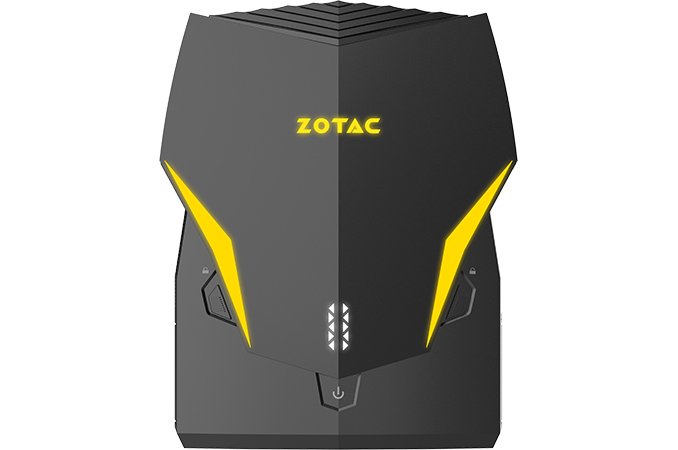Multiple makers of gaming PCs formally introduced their wearable backpack PCs for VR gaming at Computex 2016 and have never updated these systems since then. But apparently after two years, it is time for an upgrade. ZOTAC announced on Thursday that it would demonstrate its VR GO 2.0 system at Computex 2018 next week.
Having learnt from the first-generation VR GO, ZOTAC made its second-gen wearable backpack PC smaller and lighter than the original one. ZOTAC intends to disclose final specs of the unit at Computex (so stay with us), but it's likely that the new PC will be based on Intel’s Coffee Lake CPU with up to six cores, along with various SFF or mobile components (e.g., SO-DIMMs, mobile GPUs) to make the system small and more energy efficient.
The new PC retains one of the key features of the original VR GO computer (besides its wearable nature, of course) — autonomous operation enabled by built-in batteries. Meanwhile, just like its predecessor, the VR GO 2.0 can be used like a regular desktop PC: its form-factor allows it to be laid out on a desk either vertically or horizontally and all the ports will remain accessible. Speaking of ports, the new VR GO is equipped with one Thunderbolt 3/USB Type-C header, six USB 3.0 Type-A connectors, one GbE, two HDMI outputs, a DisplayPort, an SD card reader, as well as two 3.5-mm audio jack.
Following the general market trend, the VR GO 2.0 will feature ARGB lighting on the back to make the system not only feel better than the first-gen VR GO, but also look more impressive.
Preliminary specifications, ETA, and other details about the ZOTAC VR GO 2.0 will be disclosed next week at Computex, so stay tuned with us for additional information about the system.
| ZOTAC VR GO Comparison | ||
| VR GO | VR GO 2.0 | |
| CPU | Intel Core i7-6700T 4 cores/8 threads |
Intel Coffee Lake CPU up to 6 cores/12 threads (unconfirmed) |
| PCH | unknown 100-series | unknown |
| Graphics | NVIDIA GeForce GTX 1070 2048 stream processors 128 texture units 64 ROPs 256-bit memory interface 8 GB of GDDR5 8 GT/s memory |
Discrete |
| Memory | Two SO-DIMM slots 16 GB DDR4-2133 installed compatible with up to 32 GB of DDR4-2133 |
DDR4 |
| Storage | 240 GB M.2/PCIe SSD + one extra 2.5"/SATA bay |
unknown |
| Wi-Fi | 802.11ac Wi-Fi + Bluetooth 4.2 | 802.11ac Wi-Fi + Bluetooth |
| Ethernet | 2 × GbE ports (Realtek) | 1 × GbE ports |
| Display Outputs | 3 × HDMI 2.0 2 × DP 1.3 |
2 × HDMI 2.0 1 × DP |
| Audio | 3.5 mm audio in and 3.5 mm audio out | |
| USB | 6 × USB 3.0 Type-A (5 Gbps) | |
| Other I/O | DC12V-out for HTC Vive | |
| Dimensions | 410 mm × 270 mm × 76 mm 16.14 × 10.63 × 2.99 inches |
~330 mm × 220 mm × 90 mm 13 × 8.66 × 3.54 inches (unconfirmed) |
| Weight | update: 4.95 kilograms | Lighter |
| PSU | External | |
| Batteries | 2 batteries, rated at 95Wh, 6600mAh | unknown |
| OS | Windows 10 Home | Windows 10 |
| Price | $1999.99 | unknown |
Related Reading:
- ZOTAC VR GO Backpack PC Gets Priced: Core i7-6700T, GeForce GTX 1070, $1999
- ZOTAC Announces VR GO Backpack PC with GeForce GTX 1070
- HP Expands Commercial VR Strategy: Z VR Backpack and Immersion Centers
- MSI Releases the 'VR One': A Backpack PC For VR From $1999
from AnandTech https://ift.tt/2LMPtoS
via IFTTT




No comments:
Post a Comment